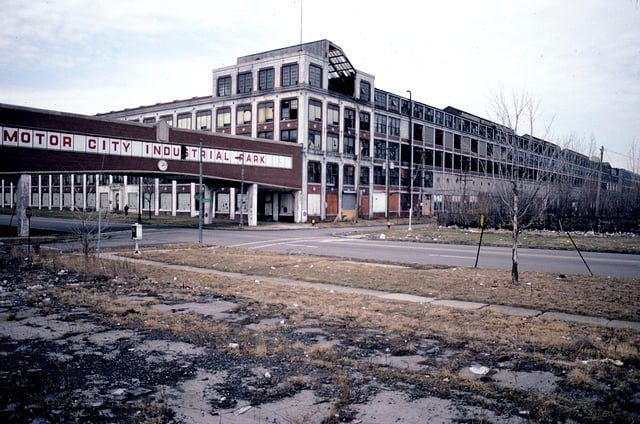Simulpocalypse #8- Reality check: Thousands of commercial real estate properties will lose significant value over the next few years
We have too many office buildings, too many dead malls, and too many warehouses, and stores in some places. In the coming years, the value of many of these buildings will drop dramatically
The abandoned Packard plant, at one time the largest factory in the United States, in Detroit, Michigan. Parts of this huge complex were abandoned in the 1950’s. The complex has been completely abandoned since 1999. Public domain photo.
Simulpocalypse- (SIGH-mole-pock-uh-lips): A word I coined to describe how we have a growing number of vacant and abandoned buildings, and post-apocalyptic looking locations in the U.S., while “normal,” everyday life goes on simultaneously.
When commercial buildings have high vacancy rates, or wind up completely empty, there’s a lot of ripple effects that we generally don’t think about. Most people drive through town, and maybe notice, “Oh, that furniture business moved out of the old Potter building,” or something of the sort. Then they forget about it and go on with their daily life. People are busy, and most people have far more pressing things to think about than vacant buildings in their city.
That’s where geeks like me, and all the Urb Ex explorers, photographers, and video producers, come in. The Urb Ex people explore, document, and often learn the stories of businesses and buildings that are in states of urban decay. Some of them make really good documentary videos about these locations. Me, I tend to look at the Big Picture surrounding subjects like this. This post is about the economic consequences of having thousands of underused, vacant, or fully abandoned buildings in the United States.
More info- On my blog: A look at some of the bigger discount sales of large commercial properties in recent years- Buildings worth tens or hundreds of millions of dollars that have sold of discounts form 36% to 97% in recent years
First, businesses in commercial buildings start to struggle, for a myriad of reasons. If they are leasing the building, then the business gets behind in lease payments. The result of that is that the building owner begins to lose income, or get delayed payments. That owner may be an individual, a small time landlord, or a gargantuan, global, bloodsucking corporation. As they lose income from the tenant, they eventually have trouble paying the mortgage or loans on the building. Very few buildings, as far as I can tell, are free and clear these days. Many, if not most, have interest only loans that get rolled over every few years. At this point, the regional bank, a large investment bank, a real estate trust, or major investors begin to lose money. The lack of payments ripple up the economic food chain.
In addition to individual businesses struggling, we have had extenuating circumstances crash the party. The Covid-19 pandemic hit, and tens of millions of people suddenly had to work from home for many months. At the same time, tens of thousands of businesses had to close down temporarily, due to the pandemic. This post is not about the politics of those closures, but the business and financial reality. Thousands of business owners couldn’t pay their lease or loan payments, and tens of thousands of businesses closed down. Then came the second part of that 1-2 punch. Interest rates went up about 3 1/2% to 4%, and stayed there. So businesses had to shut down business, offices had far fewer people in the office, and the landowners had to pay double, maybe even triple, monthly mortgage payments, when they rolled over their loans. In short order, thousands of business owners had far less money coming in, and far higher payments for their mortgage or loans. Within a year or so, building owners had stress coming from above and below, and no quick fix in sight.
This all happened on top of the longer term trend I call The Big Transition. This is my personal term for an idea put forth by futurist Alvin Toffler, way back in 1980. In his book The Third Wave, he explained that modern society was moving out of the industrial-based society, and into an information-based society. In today’s terms, we began moving out of the Industrial Age decades ago, and into an emerging Information Age.
For commercial real estate, this long transition period has huge consequences. In the 1980’s, 1990’s, and 2000’s, we saw factories get closed down, often having the operations moved to other countries. That left thousands of empty factory buildings. In the early 2000’s, we saw shopping malls begin to see their business slow down. Now we have some fully abandoned malls, and hundreds of slow, “dead malls,” with many empty stores in them. In the 2010’s, we had the Retail Apocalypse really set in, with thousands of retail stores closing down. Some of those were in the already slowing malls and shopping centers, and some were free standing stores in downtowns, or local business districts. So even before the pandemic came along, we had a decades long trend of many types of commercial buildings becoming vacant, and some were fully abandoned and fell into full scale urban decay.
Then the pandemic happened, exacerbating the problems, and slowed down business for office buildings, as well as some warehouses and industrial buildings. There are so many buildings currently struggling, that the banks and other mortgage holders don’t want to foreclose on the loans. A bank that has plenty of normal struggles in today’s weird economy doesn’t need to suddenly have to deal with a $200 million skyscraper that’s now only worth $60 million.
For about two years now, banks have been in “extend and pretend” mode. They have been doing everything possible to help building owners keep their buildings, working creative deals behind the scenes to keep some revenue coming in. The whole time, everyone involved in commercial real estate has been praying for the economy to pick up, and interest rates to go down. That wouldn’t solve the situation, but it would really, really help. Unfortunately, interest rates have stayed higher (though still not historically high), and the economy has been slowly grinding downward. Consumers struggled more and more with the prices raised by inflation, and sales of many items have slowed down.
This combination of many different factors has been putting more and more stress on our entire financial system, and we’re edging closer to a breaking point. Several large buildings, office skyscrapers in particular, have sold for pennies on the dollar, which lowers the value of other commercial real estate in those areas (see link to my blog post above). While it now appears that interest rates will begin to move lower over the next year or more, late 2025 and into 2026, it’s unlikely to be anywhere near enough to save all of the struggling business buildings.
Pure and simple, the values of tens of thousands of commercial buildings have to drop a significant amount in the next few years. Unless aliens land with flying saucers filled full of gold, and buy up 30,000 or 40,000 older office buildings, malls, and shopping centers, prices are going to drop. That’s where we are at. And there are no mega-rich aliens in sight.
We will begin to see more and more of these buildings having to be sold for huge discounts. Not just the skyscrapers in the big cities, but the small stores, the older, two to five story office buildings in every city and town, and the malls, shopping centers, and small stores that have been struggling for years. When those sales happen, whomever holds the loan, has to take a loss on their books. This wide scale devaluing, all across the U.S. (and most other leading nations), will lower the values of most of the other buildings in each area. Some banks will fail due to these losses, probably quite a few.
The next ripple effect is that each town or city gets a lot of its revenue from property taxes. When the values of buildings drop, then cities take in less tax money. That means cities need to lay off people, cut back on services, or reduce spending in other ways. Pure and simple, those vacant buildings that all of us see around town, whatever town or city you live in, are going to have a major negative effect on the local, regional, U.S., and world economies. Pretty much everyone in the commercial real estate world sees this coming, and no one has a Big Picture idea on how to deal with this crisis effectively. If we go into recession, or if we are already in one, all of these issues get worse.
Back to the key question of my whole Simulpocalypse series: How can we find viable uses for as many of these underused, vacant, and abandoned buildings, as possible?
If you check my blog post, linked above, you’ll see links to the stories of a few of the huge buildings that have sold at huge losses already. The small and medium sized sales don’t make the news, even the local news, usually. When all of these buildings that are losing value are added together, we have tens of billions, one estimate even says a trillion dollars, of equity disappearing from the United States. Similar losses are happening in other countries. This is more than enough to trigger a major economic crisis globally. That’s where we are now, and no one has a serious idea how to deal with this massive crisis sitting hidden, right in front of our eyes.
This crisis will lead to a lot of potential opportunities, as building prices drop, for new businesses and business ideas. Do you have any ideas of how to use some of the vacant buildings in your own area? In any case, there’s a lot more coming with this issue, and it will take years to fully play out. Those effects will have some influence on nearly everyone, in one way or another.
Back to Simulpocalypse Post #1
Simulpocalypse Post #9- coming soon…
There are no paid links in this post.



